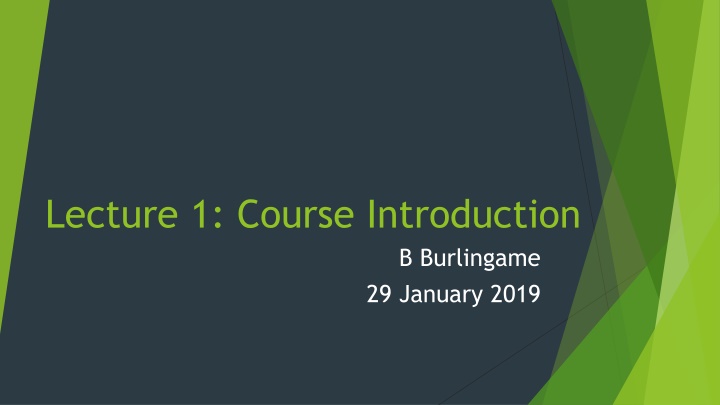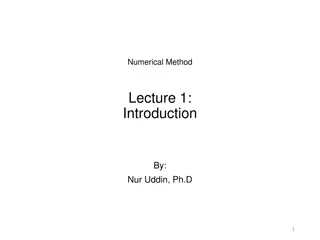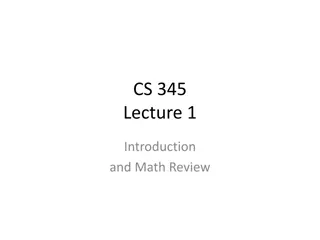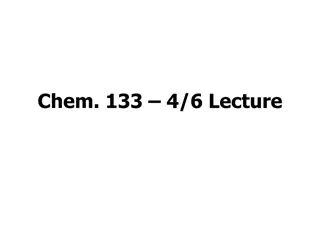
Introduction to ME 30 Course: Computers, Software Development, and Engineering
Discover the world of computers, software development, and engineering in ME 30 course led by B. Burlingame. Explore learning objectives, course structure, industry experience insights, and a pathway to become an awesome engineer. Get ready to solve problems, learn Python programming, and delve into embedded systems. Find resources, announcements, and a compelling motivation for embracing engineering as the highest form of creation.
Download Presentation

Please find below an Image/Link to download the presentation.
The content on the website is provided AS IS for your information and personal use only. It may not be sold, licensed, or shared on other websites without obtaining consent from the author. If you encounter any issues during the download, it is possible that the publisher has removed the file from their server.
You are allowed to download the files provided on this website for personal or commercial use, subject to the condition that they are used lawfully. All files are the property of their respective owners.
The content on the website is provided AS IS for your information and personal use only. It may not be sold, licensed, or shared on other websites without obtaining consent from the author.
E N D
Presentation Transcript
Lecture 1: Course Introduction B Burlingame 29 January 2019
The Plan for Today Welcome to ME 30 Introduce me Learning objectives Highlights from the syllabus (aka, greensheet ) Motivation for the course Computers & Embedded Systems Development process Creating Software Python A Python program Jupyter Notebooks Bugs
My Background Industry experience Microsoft Corporation Director of Silicon Infrastructure Dishplayer (1999) UltimateTV (2000) Xbox (2001) Xbox 360 (2005) Kinect (2010) Xbox One, Kinect II, Xbox One S (2013) Surface Book (2015) Xbox One S (2016) HoloLens (2016) Project Scorpio Xbox One X (2017) California Native Grew up in Manteca, CA (one of those places where they still grow food) Personal Hobbies: build things, fix things, cycling, scuba diving, reading literature Why Engineering? Engineering is the highest form of creation open to man. We get to harness the possibilities crafted by science to creatively enhance life s experience Why am I in this class in the middle of a work day? To help foster as many awesome engineers as possible The more brains we have to create a more interesting world, the more interesting the world shall become
Learning Objectives Solving problems with computers Learn the process for formulating a computational solution to a problem Practice the process Develop debugging techniques Gain familiarity with software and systems used for technical computing Development environments Embedded systems Data analysis Learn structured programming using the Python language Get prepared for mechatronics
Where to Find Things Syllabus available at http://me30.org spring2019@me30.org Office Hours: TBA Course information Course goals and learning objectives Textbook (both are linked to on me30.org) Think Python - How to Think Like a Computer Scientist 2nd Edition by Allen B. Downey (978-1-491-93936-9) Printed copies available from Amazon ($29.83) Automate the Boring Stuff with Python: Practical Programming for Total Beginners by Al Sweigart (978-1- 59327-599-0) Printed copies available from Amazon ($24.92) Policies and protocol Grading Resources Course schedule
Announcements For next week Read chapters 1 & 2 Install Anaconda http://www.anaconda.com Labs start today For the purpose of this class, the week starts on Wednesday Bring your laptop to Lab
Highlights from the Syllabus Grades No late work accepted All labs and homework have equal weight No late work accepted No late work accepted Lowest two will be dropped Homework + Labs comprise 50% of the final grade No late work accepted Two evaluations One around the midpoint of the term and one during finals week A problem will be assigned and you ll present the solution to me The two evaluations comprise the other 50% of the final grade No late work accepted Extra credit In class, in lab, and in homework extra credit opportunities will be offered No late work accepted Labs start next week We ll start with Python Lab are written for Jupyter Notebooks using Python Open Lab in Eng 213 Lab kits will be available around week 8 Arduino + Spartan Experimenter
Highlights from the Syllabus Grades No late work accepted All labs and homework have equal weight No late work accepted No late work accepted Lowest two will be dropped Homework + Labs comprise 50% of the final grade Two evaluations One around the midpoint of the term and one during finals week A problem will be assigned and you ll present the solution to me The two evaluations comprise the other 50% of the final grade Extra credit In class, in lab, and in homework extra credit opportunities will be offered No late work accepted No late work accepted No late work accepted Labs start next week We ll start with Python Lab are written for Jupyter Notebooks using Python Open Lab in Eng 213 Lab kits will be available around week 8 Arduino + Spartan Experimenter
Meet someone Take two minutes to meet someone in class you do not know
Computer and Embedded Systems What is a computer? A machine which: Reads input Runs some computations Generates output Repeat Each of these steps is controllable via a Program What is an embedded system? A computer embedded into a larger system What is a program? An ordered set of instructions defining the function of a computer Computers understand Machine Language A series of instructions rendered in zeros and ones, ons and offs which activate the physical hardware for each instruction Machine language is viscously difficult for us humans 1. 2. 3. 4.
Development Process Solution: High level programming language such as Python Programming language A formal language which has been designed to express computations Follows strict rules of grammar with singular meaning
Python 2007, 2010 Language of the year by TIOBE 4th most popular language (and climbing) Java, C, & C++ are ahead (though both Java and C++ are in decline) What is Python and why are we learning it? Fast development: Python is an interpreted language, the edit- test-debug cycle is quick Easy to code: Python is a relatively new language, the syntax is clear and fairly easy to read Modular: There are thousands of packages targeted at scientific and engineering computing which are easy to install and easy to use Popular: Python is widely used in industry for systems automation and data analysis Frequently, the most expensive part of an engineering project is an engineer s time. Python minimizes those tasks which cost engineering time.
Python If Python is so great, why do other languages even exist (i.e. what are Python s weaknesses)? Computationally slow: By being easy to program, the Python interpreter must do a lot of work to execute each command Memory inefficient: See above Very high level: Since so much is being done for the programmer, the programmer cannot control many aspects of how the program runs. Further, the programmer cannot directly interface with hardware unless some module exist allowing such interaction When computational efficiency outweighs programmer time, a different language is usually used.
Hello World print ( Hello World )
Running Python As an interpreted language, Python is fairly easy to port to many environments Interpreter command line Script files Jupyter Notebooks
Bugs Bug An error in a program Types of bugs Compile-time bugs Problems with the syntax of the source code which stops the compiler from being able to compile the program Run-time bugs Errors which occur while the program is running. Logic bugs Programs which compile and run fine, but do not do what is intended Debugging The process of removing bugs
Sources King, K. N. (1996) C Programming: A Modern Approach. New York, NY: W.W. Norton & Company Ltd. Downy, A.B., Scheffler, T. (2018) How to Think Like a Computer Programmer C Version. From personal correspondence with Mr. Scheffler. Publically available at http://me30.org















